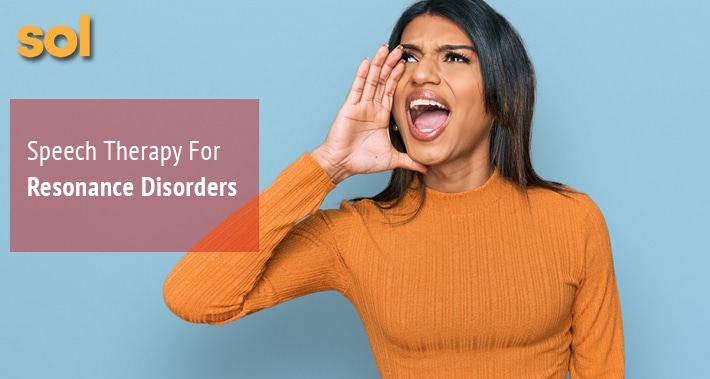
There are a number of speech disorders which influence the way we speak.
If your child is having difficulty with producing speech, speech therapy can help.
Among others, these can include articulation disorders, speed sound disorders, fluency disorders, and today’s focus, resonance disorders.
When there are issues which affect those factors, then it can result in difficulties with the way we speak and communicate with each other.
Keep reading to learn more about resonance disorders and how speech therapy can help.
What Is Speech Resonance?
Speech resonance refers to the vocal quality of sound vibrations created in the throat, mouth, and nose.
Generally, when speaking, the mouth and nose should be closed off from each other to allow for air pressure to produce speech sounds.
Additionally, factors which can contribute to speech resonance include tongue positioning, how much the mouth opens, and the shape and size of the pharynx, nasal cavity, and oral cavity.
What Is A Resonance Disorder?
Resonance disorders can be caused by structural issues, neurogenic causes, or occasionally articulation errors.
They occur as a result of changes to the way air flows through the mouth and nasal cavity when someone is speaking.
Types Of Resonance Disorders
There are a few different types of resonance disorders.
Let’s have a look at the differences between the various types.
1. Hypernasality
When there is too much vibration in the nasal cavity it’s called hypernasality.
It can make speech sounds nasal, as though the patient is speaking through their nose, and results in abnormal speech sounds.
Air may be able to be heard escaping from the nose when they produce certain consonants, including p, t, k, and s.
Additionally, certain vowel sounds, including i and u, are more susceptible to hypernasality.
Hypernasality is caused by an abnormal opening between the mouth and nose.
2. Hyponasality
While hypernasality occurs as a result of too much vibration, hyponasality is the opposite issue – not enough sound resonance (vibration) in the nasal cavity.
It’s often heard when there is a lower nasal resonance on vowels, nasal consonants (letters produced when air travels through the nasal passage) and sonorants (sounds produced by continuous airflow through the vocal tract).
This is often due to a blockage or congestion in the nasal cavity during speech.
3. Cul-De-Sac Resonance
Cul-de-sac resonance is when sound becomes “trapped”.
It can form in the pharyngeal cavity, nasal cavity, or oral cavity.
The result is sound is blocked from being fully produced.
This type of resonance disorder may be mistaken for mumbling.
4. Mixed Resonance
Mixed resonance simply means that more than one of the other three types of resonance disorder – hypernasality, hypernasality, and cul-de-sac resonance may occur together.
5. Transgender Resonance Training
While speech therapy for transgender women is not considered a resonance disorder, treatment still focuses on learning how to modify resonance.
This is because a deeper chest resonance can have a masculinizing effect on voice, while a higher resonance can create the feminizing vocal effect, which many trans women seek out.
Because this type of training is generally only necessary after completing testosterone driven puberty, it’s mostly the domain of speech therapy for adults and teenagers.
How Can A Speech Therapist Help With Resonance Disorders?
If your child is showing signs of a resonance disorder, a speech therapist can help.
They play a part in everything from screening and assessment to diagnosis to treatment of resonance disorders.
Screening for resonance disorders can involve listening to a speech sample, as well as an oral exam to look for structural and anatomical issues which could affect speech.
Speech therapy treatment for resonance disorders can be used in cases where the issue is a result of misarticulation, rather than structural causes which may need surgical interventions.
Techniques used by speech therapists may include:
- Visual feedback using a mirror
- Feedback using the See Scape, a device which detects nasal emissions
- Auditory feedback using a stethoscope
- Using an Oral and Nasal Listener device, which gives auditory feedback and amplifies speech nasality
- Real time feedback with a nasometer
As each individual will have differing needs, your pediatric speech therapist will work with you and your child to determine the course of treatment best suited for your needs.
Book Your Appointment With Sol Speech And Language Therapy
Do you suspect your child may have a resonance disorder?
Is their speech hypernasal and you can’t figure out why?
Or perhaps it’s the opposite – muffled and somewhat blocked.
Maybe they sound as though they are mumbling most of the time, making their speech hard to understand.
At Sol Speech and Language Therapy, we can help.
Each of our clinic locations have licensed speech pathologists ready to work with you and your child, to diagnose and address any speech concerns and offer treatment options designed to fit your needs.
6448 E Hwy 290 Suite E-108,
Austin, TX 78723
(512) 368-9488
» https://g.page/r/CfRfhOpEQm7BEAE
Sol Speech & Language Therapy
555 Round Rock W Dr E-221,
Round Rock, TX 78681
(512) 808-3953
» https://g.page/r/Cb5pwCTosSEfEBM
Sol Speech & Language Therapy offers personalized skilled intervention to those struggling with their speech and language skills. Services offered include screening, consultation, and comprehensive evaluation. We also provide one-on-one and/or group therapy for speech sound disorders, receptive/expressive language delay/disorder, stuttering/cluttering, accent reduction, and much more.